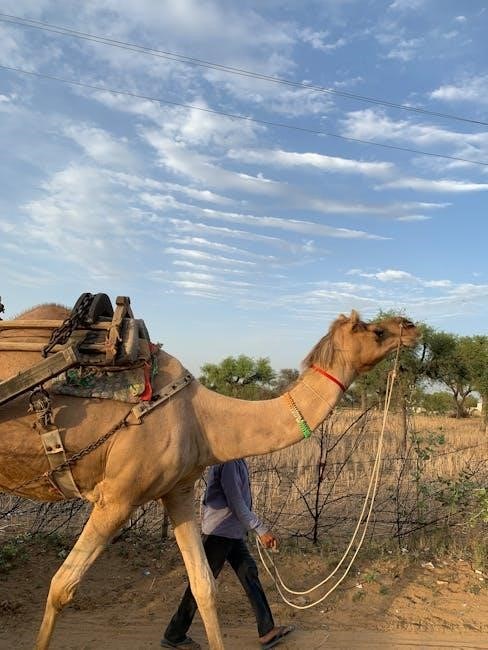guiding principles for managing wildlife resources
- by leo

Guiding principles for managing wildlife resources are essential for conservation‚ using
effective methods
and strategies to maintain healthy ecosystems and prevent overhunting‚ with government agencies regulating access to ensure sustainable use of resources always․
Background Information on Wildlife Conservation
Wildlife conservation has a long history‚ with various approaches and methods being used to manage and protect wildlife resources․ The concept of wildlife conservation dates back to the early 20th century‚ when concerns about overhunting and habitat destruction led to the establishment of laws and regulations to protect wildlife․
Today‚ wildlife conservation is a complex and multifaceted field‚ involving government agencies‚ non-profit organizations‚ and local communities․ The internet provides a wealth of information on wildlife conservation‚ including articles‚ research papers‚ and online courses․
According to online resources‚ effective wildlife conservation requires a comprehensive approach‚ taking into account the social‚ economic‚ and environmental factors that affect wildlife populations․ This includes managing human-wildlife conflict‚ protecting habitats‚ and regulating hunting and trade practices․
By understanding the background and context of wildlife conservation‚ we can better appreciate the importance of guiding principles for managing wildlife resources and work towards developing effective conservation strategies․
The use of online resources and information can help inform and guide conservation efforts‚ ensuring that wildlife resources are managed sustainably and responsibly for future generations․

Key Principles of the North American Model
Principles include public ownership‚ elimination of market hunting‚ and regulated access to ensure sustainable use of
wildlife resources always․
Public Ownership of Wildlife
The concept of public ownership of wildlife is a fundamental principle in the guiding principles for managing wildlife resources‚ where wildlife is considered a public trust resource‚ belonging to all citizens․
This principle is based on the idea that wildlife is a shared resource‚ managed by government agencies on behalf of the public‚ to ensure its conservation and sustainable use․
Public ownership of wildlife promotes the idea that wildlife is not owned by individual landowners or private companies‚ but rather is a collective resource‚ managed for the benefit of all citizens․
This approach has been instrumental in promoting conservation efforts and ensuring that wildlife resources are managed in a sustainable and equitable manner‚ with government agencies regulating access to prevent overhunting and habitat destruction․
By recognizing wildlife as a public trust resource‚ governments can work to balance the needs of different stakeholders‚ including hunters‚ farmers‚ and conservationists‚ to ensure the long-term sustainability of wildlife populations․
Overall‚ the principle of public ownership of wildlife is essential for effective wildlife management and conservation‚ and is a key component of the guiding principles for managing wildlife resources․

Foundational Principles of the North American Model

Guiding principles include
- rules
for conservation‚ with
regulations
and strategies to maintain healthy ecosystems always safely․
Seven Core Principles
The seven core principles of the North American Model are essential for managing wildlife resources‚ including the idea that wildlife is a public trust resource‚ and that science should be the basis for wildlife management decisions․
These principles also emphasize the importance of international cooperation in managing wildlife‚ as well as the need for hunting and fishing regulations to be based on sound science and to ensure the long-term sustainability of wildlife populations․
Additionally‚ the principles recognize the importance of wildlife conservation and management for the benefit of all citizens‚ and that wildlife should be managed in a way that is transparent‚ accountable‚ and responsive to the needs of the public․
The seven core principles provide a framework for managing wildlife resources in a sustainable and responsible way‚ and are widely recognized as a key component of the North American Model of wildlife conservation․
They are used by wildlife managers and conservationists to guide their decisions and actions‚ and to ensure that wildlife populations are managed in a way that is consistent with the principles of conservation and sustainability․
Overall‚ the seven core principles are an essential part of the North American Model‚ and play a critical role in ensuring the long-term health and sustainability of wildlife populations․

International Cooperation in Wildlife Management
International cooperation is crucial for managing wildlife resources‚ using
- regional agreements
and treaties to conserve and manage shared species and ecosystems effectively always with neighboring countries;
Managing Wildlife Across Borders
Managing wildlife across borders requires cooperation and agreement between countries‚ using international treaties and agreements to conserve and manage shared species and ecosystems․ This involves
- collaborative efforts
to monitor and regulate wildlife populations‚ as well as to prevent illegal activities such as poaching and wildlife trafficking․ Effective management of wildlife across borders also depends on the ability to share knowledge‚ data‚ and resources between countries․ The use of
- regional frameworks
and international organizations can facilitate this process‚ providing a platform for countries to work together to address common challenges and threats to wildlife conservation․ By working together‚ countries can help to ensure the long-term sustainability of wildlife populations and ecosystems‚ and promote the conservation of biodiversity across international borders․ This cooperative approach to wildlife management is essential for addressing the complex and interconnected nature of global wildlife conservation issues․ International cooperation is critical for managing wildlife resources and promoting conservation efforts․
Related posts:
Discover expert guiding principles for managing wildlife resources effectively at Mistitaton
Posted in Guide